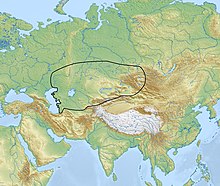
Back حضارة أندرونوفو Arabic Andronov mədəniyyəti Azerbaijani Андрон мәҙәниәте Bashkir Андронаўская археалагічная культура Byelorussian Андроновска култура Bulgarian অ্যান্দ্রোনোভো সংস্কৃতি Bengali/Bangla Cultura d'Andrónovo Catalan Andronovská kultura Czech Андрон культури CV Andronowo-Kultur German
 | |
| Geographical range | Eurasian steppe |
|---|---|
| Period | Late Bronze Age |
| Dates | c. 2000 BC – 1150 BC |
| Preceded by | Kelteminar culture, Sintashta culture, Okunev culture, Seima-Turbino phenomenon |
| Followed by | Karasuk culture, Begazy–Dandybai culture, Tasmola culture |
| Part of a series on |
| Indo-European topics |
|---|
 |
The Andronovo culture[a] is a collection of similar local Late Bronze Age cultures that flourished c. 2000–1150 BC,[1][2][3][4] spanning from the southern Urals to the upper Yenisei River in central Siberia.[5][6] Some researchers have preferred to term it an archaeological complex or archaeological horizon.[7] The slightly older Sintashta culture (c. 2200–1900 BC), formerly included within the Andronovo culture, is now considered separately to Early Andronovo cultures.[8][9] Andronovo culture's first stage could have begun at the end of the 3rd millennium BC, with cattle grazing, as natural fodder was by no means difficult to find in the pastures close to dwellings.[10][11][12]
Most researchers associate the Andronovo horizon with early Indo-Iranian languages, though it may have overlapped the early Uralic-speaking area at its northern fringe and Yeniseian-speaking area to its eastern fringe.[13][14][15] Allentoft et al. (2015) concluded from their genetic studies that the Andronovo culture and the preceding Sintashta culture should be partially derived from the Corded Ware culture, given the higher proportion of ancestry matching the earlier farmers of Europe, similar to the admixture found in the genomes of the Corded Ware population.[16]
Cite error: There are <ref group=lower-alpha> tags or {{efn}} templates on this page, but the references will not show without a {{reflist|group=lower-alpha}} template or {{notelist}} template (see the help page).
- ^ Brown, Dorcas, and David Anthony, (2017). "Bronze Age Economy and Rituals at Krasnosamarskoe in the Russian Steppes", in: The Digital Archaeological Record: "...Particular attention focuses on the role of agriculture during the unusual episode of sedentary, settled pastoralism that spread across the Eurasian steppes with the Srubnaya and Andronovo cultures (1900-1200 BC)..."
- ^ Grigoriev, Stanislav, (2021). "Andronovo Problem: Studies of Cultural Genesis in the Eurasian Bronze Age", in Open Archaeology 2021 (7), p.3: "...By Andronovo cultures we may understand only Fyodorovka and Alakul cultures..."
- ^ Parpola, Asko, (2020). "Royal 'Chariot' Burials of Sanauli near Delhi and Archaeological Correlates of Prehistoric Indo-Iranian Languages", in Studia Orientalia Electronica, Vol. 8, No. 1, Oct 23, 2020, p.188: "...the Alakul’ culture (c.2000–1700 BCE) in the west and the Fëdorovo culture (c.1850–1450 BCE) in the east..."
- ^ Cite error: The named reference
Degtyarevawas invoked but never defined (see the help page). - ^ Baumer, Christoph (18 April 2018). History of Central Asia, The: 4-volume set. Bloomsbury Publishing. p. 136. ISBN 978-1-83860-868-2. "It is assumed that the Indo–Iranian language family, which appeared around 2200 bc, was related to the cultural complex of Andronovo in eastern Central Asia."
- ^ Mallory 1997, pp. 20–21
- ^ Anthony, David W. (2007). The Horse The Wheel And Language. How Bronze-Age Riders From the Eurasian Steppes Shaped The Modern World. Princeton University Press.
- ^ Koryakova 1998a.
- ^ Hoshko, Tatiana, (2019). "Oriental Technologies in the Production of Cauldrons of Late bronze Age", in _Historiography, Source Studies and Special Historical Disciplines_,SKHID No. 2 (160) March–April 2019, p. 87.
- ^ Bendezu-Sarmiento, Julio, 2021. “The first nomads in Central Asia’s steppes (Kazakhstan): An overview of major socio-economic changes, derived from funerary practices of the Andronovo and Saka populations of the Bronze and Iron Ages (2nd-1st millennium BCE)”, in: Nomad lives: From Prehistoric Times to the Present Day, Publications scientifiques du Muséum, Paris, pp. 479-503.
- ^ Bendezu-Sarmiento, Julio, 2021. “The first nomads in Central Asia’s steppes (Kazakhstan)", Summary (in French): "...Durant la première étape de la culture d’Andronovo (Bronze ancien à la fin du IIIe millénaire avant n.è.), le cheptel (principalement constitué de bovins) était réduit et le fourrage naturel n’était nullement difficile à trouver dans les pâturages proches des habitations..."
- ^ Bendezu-Sarmiento, Julio, (2022). "The first nomads in Central Asia’s steppes (Kazakhstan): Territory, power and religion", in: Eurasian steppe civilization: Human and the Historical and Cultural Environment, Almaty–Turkistan, p. 48: "During the first stage of the Andronovo culture (Early Bronze Age to the end of the 3rd millennium BC), the livestock (mainly cattle) was small and natural fodder was not difficult to find in the pastures near the settlements."
- ^ Beckwith 2009, p. 49: "Archaeologists are now generally agreed that the Andronovo culture of the Central Steppe region in the second millennium BC is to be equated with the Indo-Iranians."
- ^ Cite error: The named reference
:2was invoked but never defined (see the help page). - ^ Bjørn, Rasmus G. (2022-04-22). "Indo-European loanwords and exchange in Bronze Age Central and East Asia". Evolutionary Human Sciences. 4: e23. doi:10.1017/ehs.2022.16. ISSN 2513-843X. PMC 10432883. PMID 37599704.
- ^ Allentoft, Morten; Sikora, Martin (2015). "Population genomics of Bronze Age Eurasia". Nature. 522 (7555): 167–172. Bibcode:2015Natur.522..167A. doi:10.1038/nature14507. PMID 26062507. S2CID 4399103.